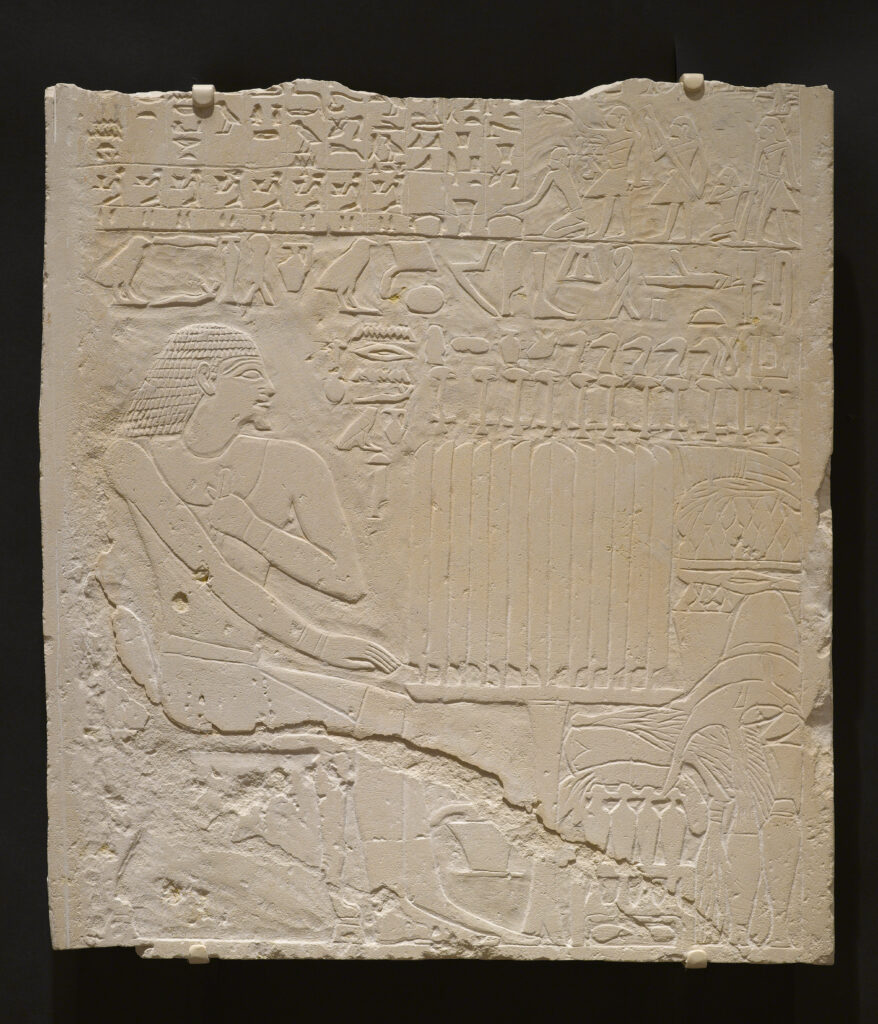Reliefs from the Tomb of Khnumti 1 and 2 (work of art)
Artwork Info
Key Ideas
- These carvings from the Tomb of Khnumti were part of a small shrine with a back (false door) and bottom that served as an offering tray. This shrine was located in a part of a tomb that was accessible to visitors.
- These carvings feature two types of relief: bas relief and sunken relief. In a bas relief, the sculpture is raised only slightly from its background surface. In a sunken relief, the carved area is below the level of the surrounding surface. Sunken relief carving is mostly found in ancient Egyptian art.
- Khnumti is the seated human figure who is depicted on both stone pieces. He is surrounded by offerings, including 12 loaves of bread on the table, leeks on the left side, and fruit, vegetables, and a duck on the right side. The sunken relief hieroglyphic text above Khnumti’s head promises him bread, beer, cattle, fowl, alabaster, and linen. The line of repeated plant symbols means he will get thousands of these things in the afterlife.
- Khnumti’s head, arms, and legs are shown in profile (from the side), while his eye, shoulders, and chest are shown from the front. This style of art is called frontalism. It is typical of Egyptian art.
- Shrines are a place or monument that gives the living the opportunity to pay tribute to deities, a deceased person, or an historical event depending on the situation. Examples of shrines include ofrendas in Mexican culture, Shinto shrines in Japan, or monuments such as the Tomb of the Unknown Soldier at Arlington National Cemetery.
- The second relief is almost a mirror image (or a reflection) of the first relief. Khnumti is seated in a similar pose, but he is holding a folded cloth in his bent left arm. In order to show both arms, the artist depicted Khnumti’s left arm at an awkward angle across his chest.
Learn More
These reliefs from a tomb chapel symbolically provide for the needs of the deceased through all eternity. In the first relief, Khnumti is seated at a table with 12 loaves of bread on it. A variety of vessels and a bundle of leeks are shown under the table. Khnumti wears a kilt and a broad collar. His head, arms, and legs are shown in profile, and his eye, shoulder, and torso are shown frontally. This style of art, known as frontalism, is typical of ancient Egyptian sculpture.
The hieroglyphic text above Khnumti’s head promises him bread, beer, cattle, fowl, alabaster, and linen. The line of repeated plant symbols indicates thousands of these provisions. Columns of text in sunken relief below the broken top edge extend a menu of offerings. In the top left section of the first relief, there are five human figures, three of whom wear sashes identifying them as lector priests like Khnumti. A lector priest is one who reads sacred texts for religious observances. The first figure kneels before a low offering table; the last walks away from the scene, dragging a broom to clean and perfume the chamber in final preparation of the tomb for Khnumti’s afterlife.
The second relief from the same tomb was originally part of a panel on the opposite wall. Almost a mirror image of the first relief, its differences provide information about the artist’s technique. The figure of Khnumti is seated in a similar pose, but in order to portray both the right arm reaching toward the table and the whole left arm with its hand holding a folded cloth, the left arm is bent awkwardly back across the chest. The area beside the table features a wealth of offerings, including fruits and vegetables, vessels, and a trussed duck. Most of these offerings are only outlined with incision, a preliminary step to removing the stone from the background to create the low raised relief seen in the more finished section of the panel. The inscription above the figural scene is striking in its unfinished state, with the marks of the chisel still visible in the background. It is tempting to suppose that the hasty execution of this panel was due to the unexpected need to prepare quickly for Khnumti’s burial.
tags: ancient Egypt, communication, cycle, interdependence, ritual, survival
Additional Resources
Resources for Teachers
- Learn about the different types of relief sculptures.
- Read about modern twists on relief sculptures.
- Understand frontalism.
Resources for Students


